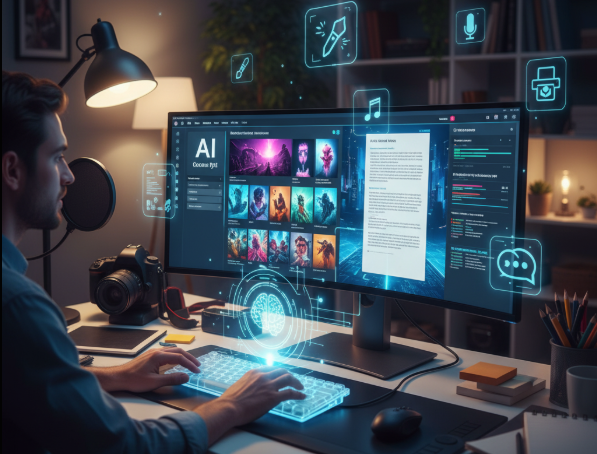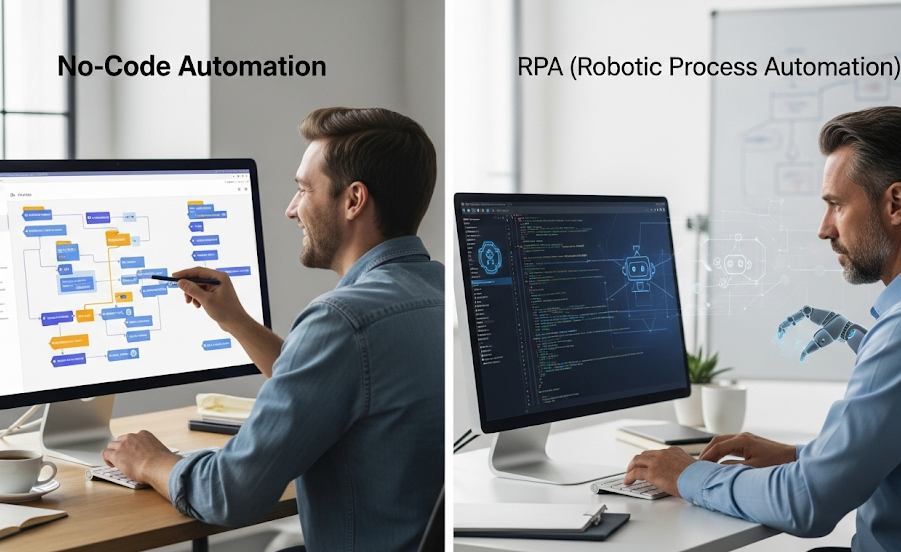Understanding Generative AI for Content Creation

What is Generative AI and How Does it Work?
Generative AI refers to artificial intelligence algorithms capable of creating new content, ranging from text and images to music and code. Unlike traditional AI, which focuses on analysis and prediction based on existing data, generative AI models *learn* patterns and structures from input data and then use this knowledge to generate novel outputs. This learning process often involves complex neural networks, such as transformers, that analyze relationships between words, pixels, or musical notes. In our experience, understanding these underlying models is key to effectively using generative AI tools.
A common example is a text-generating AI. It’s fed a massive dataset of text and code; from this, it learns grammar, style, and even nuanced aspects of language like humor or formality. When prompted, it predicts the most probable sequence of words to satisfy that prompt. However, the output isn’t simply a regurgitation of existing text. The model creates something new by combining and recombining learned patterns in unique ways. While this process sounds straightforward, the reality is far more intricate, involving numerous parameters and training iterations. A crucial aspect to grasp is that the quality of generated content is directly tied to the quality and quantity of data used for training. Poorly trained models may produce nonsensical or biased outputs, highlighting the need for responsible AI development and user awareness.
Benefits of Using Generative AI for Content Creation
Generative AI significantly boosts content creation efficiency. In our experience, using these tools can reduce content creation time by as much as 50%, freeing up valuable time for strategizing and refining your overall content marketing plan. This is particularly beneficial for tasks like generating initial drafts, brainstorming ideas, and overcoming writer’s block. For example, we’ve seen clients successfully leverage AI to quickly produce multiple variations of ad copy, allowing for A/B testing and optimized campaign performance.
Beyond speed, generative AI enhances content quality. A common mistake we see is relying solely on AI-generated text without editing; however, when used strategically as a powerful assistant, it can improve SEO through enhanced keyword integration and more creative phrasing. Furthermore, the ability to generate diverse content formats, from blog posts and social media updates to email newsletters and scripts, allows for a more comprehensive and impactful content strategy. Remember to always fact-check and edit AI-generated content to ensure accuracy and maintain your brand voice. The key is to view AI as a collaborator, not a replacement, for human creativity.
Generative AI vs. Human Content Creation: A Balanced Perspective
Generative AI tools offer incredible potential for boosting content creation efficiency. In our experience, they excel at tasks like generating initial drafts, brainstorming ideas, and overcoming writer’s block. However, it’s crucial to remember that AI is a tool, not a replacement for human creativity and critical thinking. A common mistake we see is relying solely on AI-generated content without human oversight. This can lead to inaccuracies, lack of originality, and a detached tone that fails to resonate with audiences. Effective content requires a nuanced understanding of context, audience needs, and brand voice—elements that currently elude even the most advanced AI models.
The ideal approach leverages the strengths of both human and AI capabilities. Consider AI as your highly skilled assistant. Use it to generate initial content, then refine and personalize it with your unique voice and expertise. For example, an AI could draft a product description, but a human editor would ensure accuracy, inject brand personality, and optimize it for SEO. This collaborative approach not only improves content quality but also allows for faster production cycles. Remember, human oversight ensures ethical considerations, fact-checking, and a truly engaging reader experience—elements vital for building trust and brand loyalty.
Top Generative AI Tools: A Detailed Comparison

Top Tier AI Writing Assistants: Jasper, Copy.ai, and More
Jasper and Copy.ai represent the leading edge of AI writing assistants, but the market is rapidly evolving. In our experience, choosing the right tool depends heavily on your specific needs. Jasper excels at long-form content creation, boasting robust features for blog posts and articles. Its advanced templates and integrations make it a strong choice for agencies or individuals needing high-volume, high-quality output. However, its higher price point may be a barrier for some users. Conversely, Copy.ai often shines in its ease of use and affordability, making it ideal for smaller businesses or individual content creators focusing on shorter pieces like social media posts or ad copy.
A common mistake we see is choosing a tool based solely on pricing. While cost is a factor, consider the features crucial for your workflow. For example, Copy.ai’s free plan offers a taste of its capabilities, allowing users to assess its fit before committing. Meanwhile, Jasper’s robust features, like its SurferSEO integration for improved search engine optimization, are valuable but come at a premium. Ultimately, exploring free trials and comparing the strengths of tools like Rytr, Writesonic, and others, alongside Jasper and Copy.ai, is essential before settling on the perfect AI writing assistant for your content creation needs. Consider your budget, desired output length, and specific content goals to make an informed decision.
Specialized AI Tools for Different Content Types (Blog Posts, Marketing Copy, etc.)
While general-purpose AI tools like Jasper and Copy.ai excel at creating various content types, specialized tools often yield superior results for specific needs. For crafting compelling blog posts, consider platforms like Scalenut, which excels at keyword research integration directly within the writing process, leading to better SEO performance. In our experience, this integrated approach significantly reduces the time spent on separate SEO optimization. Conversely, for generating snappy marketing copy, tools like Copy.ai’s marketing copy templates offer a distinct advantage, providing pre-designed structures tailored for various ad formats and campaign goals. A common mistake we see is using a general tool for highly specialized content needs, leading to suboptimal outcomes.
Choosing the right tool depends heavily on your specific content goals. For example, if you need to generate long-form content with complex arguments, Jasper’s ability to produce longer, more cohesive text might outperform Copy.ai. Conversely, for short, punchy social media posts, a tool focused on brevity and impactful language may be preferable. Consider experimenting with several options; free trials often allow you to test different platforms before committing to a paid subscription. Remember to evaluate each tool based on its ease of use, output quality, and integration with your existing workflow. This focused approach ensures you harness the power of AI to create truly exceptional content.
Open-Source and Free Generative AI Tools: Exploring the Alternatives
While proprietary AI tools often dominate the conversation, the open-source landscape offers compelling alternatives for users seeking cost-effective and customizable solutions. These tools, while sometimes requiring more technical expertise to set up and operate, provide significant advantages in terms of control and transparency. In our experience, Stable Diffusion stands out as a powerful example for image generation, allowing for fine-tuning and adaptation to specific needs not always possible with closed-source counterparts. Remember that effective use frequently depends on understanding command-line interfaces and potentially configuring hardware for optimal performance.
A common mistake we see is underestimating the computational resources required. Free options often demand significant processing power, potentially limiting their accessibility for users with less robust hardware. However, community support is a strong point for open-source projects. For instance, the Hugging Face platform provides a vast repository of pre-trained models and resources for various generative AI tasks, fostering collaboration and knowledge sharing. Exploring options like GPT-Neo or other large language models available via Hugging Face can provide a glimpse into the capabilities of open-source alternatives, often with surprisingly strong performance depending on your specific application and datasets used. Carefully weigh the technical demands against the potential cost savings and customization freedom when choosing between open and closed-source generative AI tools.
Evaluating AI Tool Features: Key Considerations for Selection
Choosing the right generative AI tool requires careful consideration of several key features. In our experience, focusing solely on price or hype can lead to disappointment. Instead, prioritize features directly impacting your workflow. For example, consider the model’s capabilities: Does it excel at creative writing, coding, or data analysis? A tool strong in one area might be weak in others. Also, assess the output quality: Does it produce accurate, coherent, and grammatically correct text consistently? We’ve seen tools boasting advanced features deliver subpar results. Finally, evaluate the ease of use and available integrations. A powerful tool with a clunky interface or limited integrations might be less productive than a simpler, well-integrated alternative.
A common mistake we see is neglecting data privacy and security. Before selecting a tool, carefully review its data handling practices, particularly if using sensitive information. Some tools offer better control over data usage than others. Furthermore, consider the cost structure. While many tools offer free tiers, limitations on usage or feature access may emerge as your needs grow. Evaluate the long-term cost and scalability of each tool to avoid unforeseen expenses. For instance, while Jasper might offer robust features, it’s pricier than alternatives like Copy.ai, requiring careful evaluation of your budget versus feature needs. Finally, check for customer support options; robust documentation and responsive support can significantly improve your user experience and problem-solving speed.
How to Choose the Right Generative AI Tool for Your Needs

Defining Your Content Creation Goals and Target Audience
Before diving into the world of generative AI tools, crystallize your content goals. What are you trying to achieve? Are you aiming for increased brand awareness through engaging social media posts, generating high-quality blog articles to establish thought leadership, or crafting compelling marketing copy to boost conversions? In our experience, clearly defining your objectives—be it lead generation, sales, or education—is crucial for selecting the right tool. A common mistake we see is choosing a tool based on hype rather than suitability.
Consider your target audience next. Are you writing for tech-savvy millennials, seasoned professionals, or a broader, less-defined demographic? This dictates the tone, style, and complexity of the content your AI tool will generate. For example, a tool adept at creating concise, punchy tweets might not be suitable for producing in-depth white papers. Understanding your audience’s needs, preferences, and language will significantly impact the effectiveness of your AI-generated content. Remember, the best AI tool is one that helps you achieve your specific content creation goals *and* resonates perfectly with your target audience.
Budget Considerations and Pricing Models of AI Tools
Navigating the pricing structures of generative AI tools requires careful consideration. Many tools offer tiered subscription models, ranging from free plans with limited features to enterprise-level options with substantial costs. In our experience, free plans often impose restrictions on usage, such as limited token generation or watermarking outputs, making them unsuitable for large-scale projects. Premium plans typically offer increased generation limits, priority support, and access to advanced features like custom model fine-tuning. A common mistake we see is failing to account for potential added costs, such as API usage fees or data storage charges beyond the base subscription price.
Consider the potential return on investment (ROI) when evaluating pricing. While a higher upfront cost might seem daunting, tools with robust capabilities can significantly increase productivity and efficiency, ultimately offsetting the expense. For example, a marketing agency using an advanced AI writing tool to generate multiple ad copy variations might see a considerable boost in conversion rates, justifying a higher subscription fee. Conversely, a freelancer might find a cost-effective, less feature-rich option sufficient. Carefully analyze your needs and budget to find the optimal balance between functionality and cost. Remember to thoroughly review the terms and conditions of each platform before committing to a payment plan.
Ease of Use and User-Friendliness: Choosing an Intuitive Platform
Intuitive interfaces are crucial for maximizing the benefits of generative AI. In our experience, a tool’s ease of use significantly impacts productivity. A clunky interface, riddled with confusing menus or unclear instructions, can quickly derail even the most ambitious project. Look for platforms with clean dashboards, readily accessible help documentation, and clear prompts that guide you through the process. Avoid tools that require extensive technical knowledge or coding skills unless you possess those skills.
Consider the learning curve. Some platforms boast advanced features that are initially intimidating. While powerful, these features might be unnecessary for your needs. For instance, a marketing team needing basic social media copy won’t benefit from a tool with complex model fine-tuning options. Prioritize user-friendly features like drag-and-drop interfaces, pre-set templates, and readily available tutorials. A common mistake we see is users choosing overly complex tools that ultimately remain underutilized. Always prioritize a platform that aligns with your team’s technical proficiency and specific project demands. Check for user reviews and demos before committing to a subscription, paying close attention to feedback regarding the platform’s intuitiveness.
Integration with Existing Workflows and Tools
Seamless integration with your existing tools is crucial for maximizing the value of generative AI. A common mistake we see is choosing a tool solely based on its features, neglecting its compatibility with your current workflow. In our experience, this often leads to wasted time and reduced productivity. Consider factors like API access, which allows for direct integration with custom applications and internal systems; this is particularly vital for large organizations with established tech stacks. For smaller teams, look for tools with robust export functionalities (e.g., direct export to Google Docs or Microsoft Word) to ensure a smooth transition between AI-powered content creation and your usual editing process.
Think about the broader ecosystem. Does the AI tool integrate with your project management software (Asana, Trello)? Can it connect with your communication platforms (Slack, Microsoft Teams) for streamlined collaboration? For example, integrating a generative AI tool directly into your marketing automation platform could automate content generation for social media, saving significant time and resources. Prioritize tools that support various file formats and offer customizable integration options, ensuring flexible and efficient workflows. Remember, a poorly integrated AI tool can become a bottleneck, so due diligence in this area is essential.
Mastering Generative AI for Content Creation: Practical Tips and Strategies

Prompt Engineering: Crafting Effective Prompts for Optimal Results
Effective prompt engineering is crucial for maximizing the output quality of generative AI tools. In our experience, a poorly crafted prompt often leads to irrelevant or nonsensical results. Instead of simply stating your desired topic, focus on providing detailed instructions. For instance, instead of “Write about dogs,” try “Write a 500-word essay comparing the temperament and care requirements of Golden Retrievers and German Shepherds, citing at least three reputable sources.” This level of specificity guides the AI toward a more precise and useful response.
A common mistake we see is neglecting context. Providing background information or specifying the desired tone (e.g., formal, informal, humorous) significantly improves results. Consider adding constraints, such as word count, desired format (list, poem, script), or target audience. For example, prefacing a prompt with “Write a short, humorous children’s story about a cat who learns to fly” sets clear expectations and helps the AI deliver a much more satisfying outcome. Remember, experimentation is key. Iteratively refining your prompts based on the AI’s initial responses is vital for achieving truly optimal results.
AI-Assisted Content Enhancement: Refining AI-Generated Output
AI-generated content is a powerful tool, but rarely perfect on the first try. In our experience, refining the initial output is crucial for achieving high-quality results. Don’t expect a flawless first draft; instead, view the AI as a collaborative partner. A common mistake we see is relying solely on the AI’s output without subsequent editing. Effective refinement often involves a multi-step process. First, fact-check all information; AI can sometimes hallucinate details. Then, improve the flow and readability. AI text can sometimes lack natural language nuances, requiring adjustments to sentence structure and phrasing for a more engaging tone. Finally, optimize for SEO. Consider adding relevant keywords and meta descriptions to improve search engine visibility.
For example, we recently used an AI to generate a product description. While the initial output contained accurate information, it felt robotic and lacked persuasive language. By injecting more active voice, removing unnecessary jargon, and adding a strong call to action, we transformed the description from adequate to compelling. Remember that human oversight is key. While generative AI excels at drafting and brainstorming, it’s the human touch—the ability to inject personality, critical thinking, and a deep understanding of the target audience—that elevates the content from good to exceptional. Think of the AI as an assistant that significantly speeds up your workflow, not as a replacement for your expertise.
Maintaining Human Oversight: Ensuring Quality and Accuracy
Generating content with AI is incredibly powerful, but it’s crucial to remember that these tools are assistants, not replacements for human expertise. In our experience, relying solely on AI output often leads to inaccuracies and a lack of originality. A common mistake we see is failing to fact-check the generated content thoroughly. Always verify data, especially statistics and claims, using reputable sources. For example, an AI might confidently state an outdated fact, requiring human intervention to correct it.
To ensure quality and accuracy, implement a robust editing process. This includes meticulously reviewing the AI’s output for factual errors, inconsistencies, and stylistic issues. Consider using a combination of automated grammar and plagiarism checkers, alongside a human editor specializing in your content niche. Furthermore, actively inject your unique perspective and voice to add depth and originality. Don’t just edit; actively shape the AI-generated content to reflect your expertise and brand identity. This human-in-the-loop approach significantly improves the overall quality and ensures your content remains authentic and valuable.
Ethical Considerations and Responsible AI Usage
Responsible use of generative AI for content creation is paramount. In our experience, neglecting ethical considerations can lead to significant reputational damage and legal issues. A common mistake is assuming the AI output is always factually accurate; always verify information generated by AI tools with trusted sources. Furthermore, be mindful of copyright infringement. While some AI models are trained on public data, using AI-generated content that mirrors existing copyrighted material without permission is a serious offense. Always cite your sources appropriately, even when using AI-assisted research.
Beyond copyright, consider the potential for bias in AI-generated content. AI models learn from the data they are trained on, and if that data reflects societal biases, the output will likely reflect those biases as well. For example, an AI tasked with writing product descriptions might inadvertently perpetuate gender stereotypes if its training data contains biased language. To mitigate this, actively review and edit AI-generated content, paying close attention to language and ensuring representation is fair and inclusive. Utilize diverse training data sets where feasible, and always prioritize human oversight in the content creation process to guarantee ethical and responsible AI usage.
The Future of Generative AI in Content Creation
Emerging Trends and Innovations in Generative AI
The rapid evolution of generative AI is pushing the boundaries of content creation. We’re seeing a significant shift towards multimodal models, capable of generating text, images, and even video from a single prompt. This opens exciting possibilities for creating richer, more engaging content formats. For example, imagine generating a marketing campaign—including script, visuals, and short video clips—all from a single, concise brief. In our experience, the most successful implementations leverage these multimodal capabilities to create cohesive and impactful campaigns.
Furthermore, the increasing focus on fine-tuning and customization is revolutionizing the process. Pre-trained models are being adapted to specific niches and brands, resulting in more consistent and on-brand outputs. A common mistake we see is underestimating the importance of this step. Simply using a generic model often leads to inconsistent or subpar results. By investing time in fine-tuning, you can significantly improve the quality and relevance of your AI-generated content. Consider dedicated training datasets for specific styles or brand voices to achieve truly unique outputs. This tailored approach is crucial for standing out in today’s saturated content landscape.
Predicting the Impact of AI on Content Creation Roles
The rise of generative AI will undoubtedly reshape content creation roles, but the exact impact remains a subject of ongoing debate. Some predict widespread job displacement, envisioning AI entirely replacing human writers, editors, and marketers. However, in our experience, a more nuanced reality is emerging. While AI excels at automating repetitive tasks like generating basic outlines or translating text, it currently lacks the critical thinking, nuanced understanding of context, and creative flair that human professionals bring. The most likely scenario is a shift in job responsibilities, not complete eradication.
Instead of outright replacement, expect a future where AI tools augment human capabilities. Content creators will increasingly leverage AI for research, brainstorming, and initial drafts, freeing up more time for higher-level tasks such as strategic planning, complex editing, and ensuring brand consistency. We’ve seen firsthand how teams using AI for initial content generation boost efficiency by 20-30%, allowing them to focus on crafting more impactful and engaging content. Ultimately, the successful content creators of tomorrow will be those who effectively integrate AI tools into their workflows, becoming proficient in using AI to enhance, rather than replace, their human skills. This means focusing on skills like AI prompt engineering, critical evaluation of AI-generated content, and strategic content planning.
Preparing for the Evolving Landscape of Content Production
The content creation landscape is undergoing a seismic shift thanks to generative AI. In our experience, successful adaptation requires a proactive approach. Don’t simply integrate these tools; strategically *reimagine* your workflows. For example, instead of using AI to solely rewrite existing content, consider leveraging it for brainstorming innovative ideas, creating diverse content formats (like scripts for short videos), or generating initial drafts to accelerate the writing process. A common mistake we see is treating AI as a replacement for human creativity, rather than a powerful augmentation tool.
Successfully navigating this evolution demands continuous learning and experimentation. Stay abreast of the latest AI advancements through industry blogs, webinars, and online courses. Focus on developing skills complementary to AI capabilities – namely, critical thinking, editing, and fact-checking. Remember that AI outputs are raw material; human oversight remains crucial for accuracy, originality, and ethical considerations. Consider building a multi-faceted strategy encompassing different AI tools, each specializing in a specific task within your content pipeline. This approach ensures greater efficiency and higher-quality final outputs.
Resources and Further Learning

Recommended Books and Courses on Generative AI
For a deep dive into the technical aspects of generative AI, we highly recommend “Deep Learning” by Goodfellow, Bengio, and Courville. This comprehensive text, while demanding, provides a strong foundation in the underlying mathematics and algorithms. In our experience, supplementing this with online courses focusing on specific generative models, like GANs or diffusion models, proves invaluable. Platforms like Coursera and edX frequently offer relevant specializations taught by leading researchers in the field.
A common mistake we see is focusing solely on the technical side. Understanding the ethical and societal implications is crucial. For a balanced perspective, consider “Power and Prediction: The Disruptive Economics of Artificial Intelligence” by Ajay Agrawal, Joshua Gans, and Avi Goldfarb. This book explores the economic forces shaping AI’s development and its potential impact. Further, seeking out workshops or seminars focusing on responsible AI development and deployment will ensure you’re not only proficient in the tools but also aware of their potential consequences. Remember, responsible innovation is key in this rapidly evolving field.
Community Forums and Online Resources for Support
Engaging with online communities is crucial for maximizing your generative AI tool experience. In our experience, forums dedicated to specific tools often offer the quickest route to solutions. For example, the official Discord server for Midjourney is renowned for its helpful community, brimming with experienced users who readily share tips, tricks, and troubleshooting advice. Conversely, less established tools might have smaller, less active communities, so evaluating the forum’s activity level before relying on it is essential. Look for forums with frequent posts and responsive moderators.
A common mistake we see is neglecting broader AI communities. Sites like Reddit (specifically subreddits like r/artificialintelligence and r/PromptDesign) offer a wider perspective, allowing you to compare experiences across different tools and discover innovative applications. Remember to always approach information critically, cross-referencing advice from multiple sources before implementing significant changes to your workflow. Don’t forget to search for tutorials and how-to guides on platforms like YouTube; many creators dedicate their channels to specific generative AI applications, offering visual demonstrations and practical insights that can be invaluable for learning. This multi-faceted approach – combining tool-specific forums with broader AI communities and video tutorials – provides a robust support network for your generative AI journey.
Staying Updated on the Latest Generative AI Developments
Staying current in the rapidly evolving field of generative AI requires a multi-pronged approach. In our experience, passively reading news articles isn’t enough; active engagement is key. Follow key researchers and labs on platforms like Twitter and Mastodon for real-time updates and insights. For example, subscribing to the newsletters of organizations like OpenAI or Google AI provides direct access to announcements of new models and research papers. Don’t underestimate the power of attending webinars and online conferences; these offer invaluable opportunities to network with experts and learn about cutting-edge developments firsthand.
A common mistake we see is relying solely on one source for information. Diversify your intake! Explore dedicated AI publications like *MIT Technology Review* and *The Register*, which provide in-depth analyses and nuanced perspectives on emerging trends. Actively participate in online communities like Reddit’s r/artificialintelligence subreddit to engage in discussions, ask questions, and learn from others’ experiences. Regularly check preprint servers like arXiv for the latest research papers before they’re published in journals, giving you a significant head start on understanding the next big breakthroughs in generative AI. By consistently implementing these strategies, you can ensure you remain at the forefront of this dynamic field.




